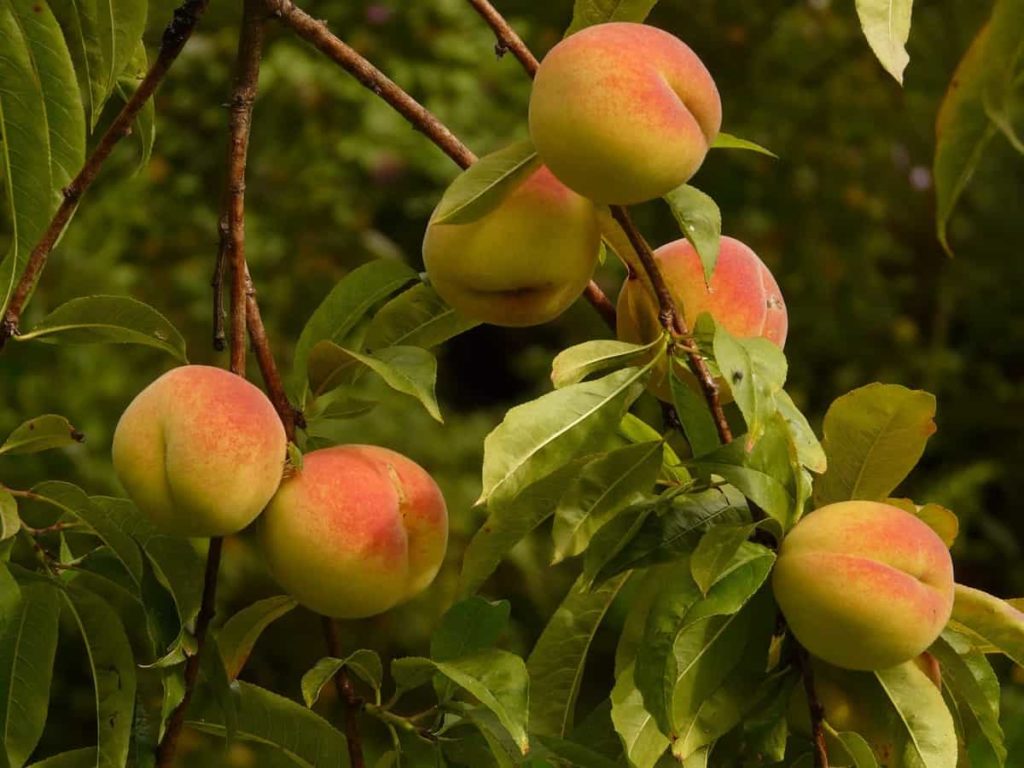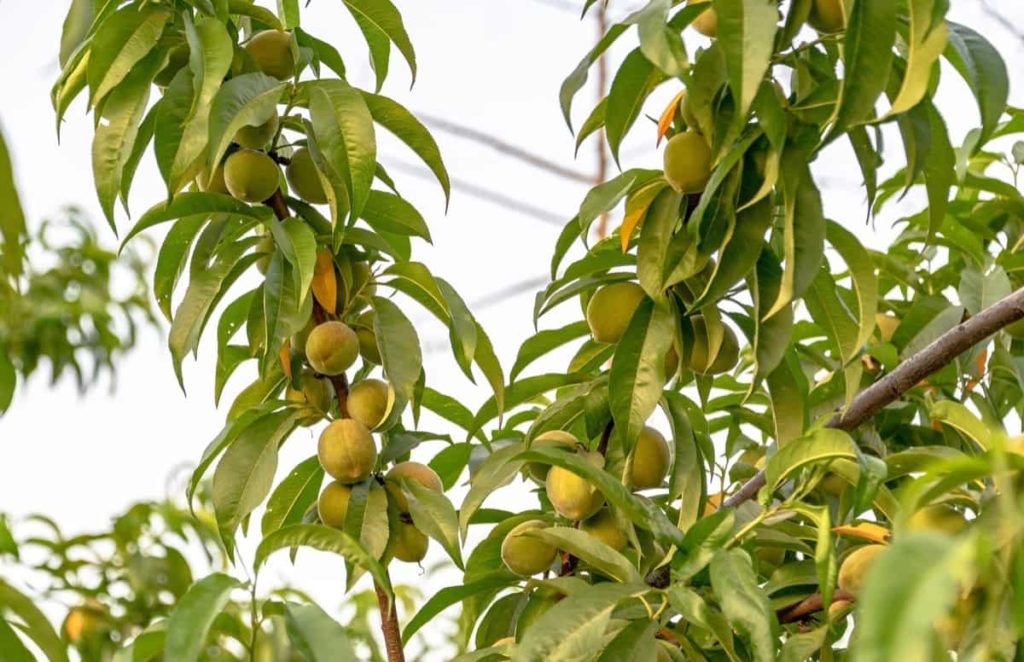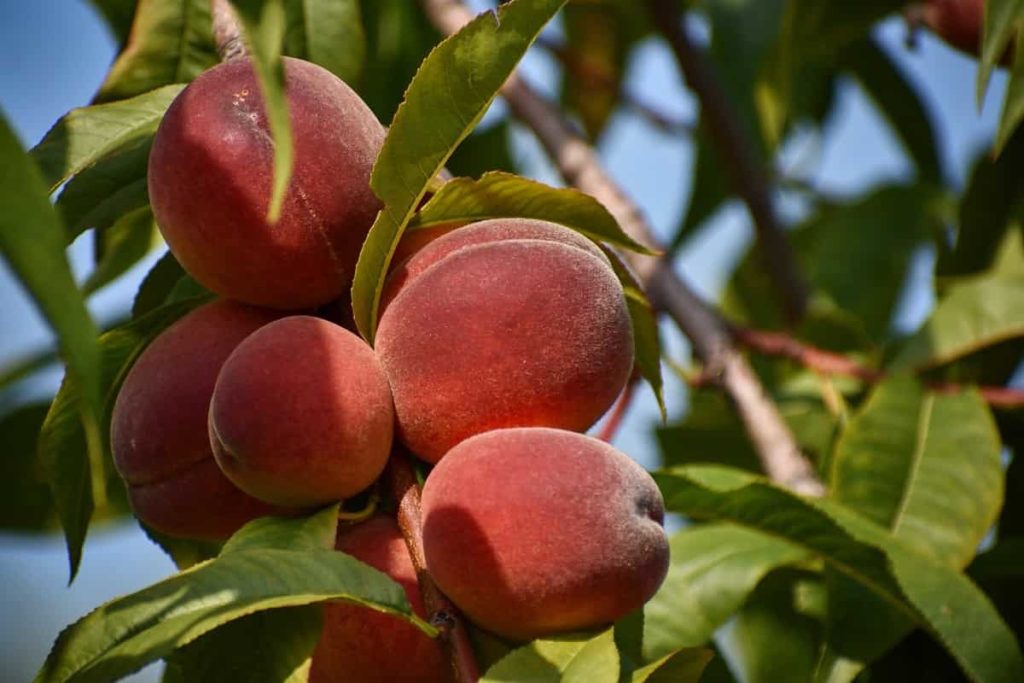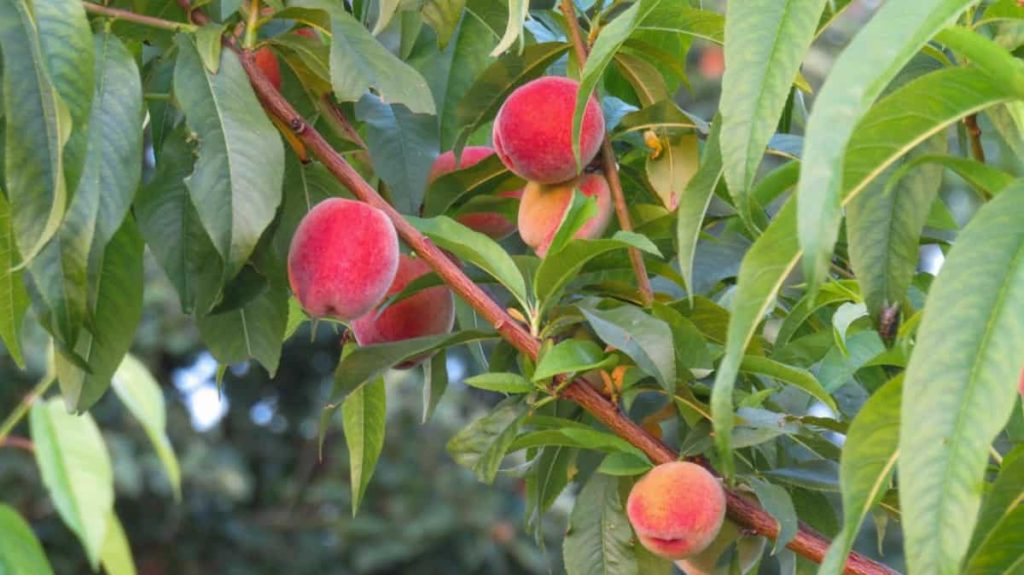Grow a Peach tree in your yard, the rewards are great, but the maintenance of Peach trees demands careful attention so they do not suffer from some common Peach diseases. It is important to learn the symptoms of the common Peach disease so you can jump on their management and avoid these problems in the future. Avoid excessive water, check water and soil, and modify as needed earlier in the day.

With proper care, your Peach tree should return to its happy self in no time. Homegrown Peaches taste entirely different from those bought from the shop. They are sweet and have a more intense depth of taste. You may be denied this sweet treat if your Peach tree suffers from problems like lack of fruit or diseases.
Common Peach tree problems
Stunted growth, dying trees
Sudden death is a sign of root or crown rot. Other signs are stunted shoot growth and lost leaves; the remaining ones are small and yellow. The fruits of the affected tree will be small and sunburned. With the crown rotting, you can see rotting on the stems around the soil line.
Solution – The best way to avoid this problem is careful water management and ensuring that your Peach tree is well in a draining position. Improve drainage if you can.
Healthy leaves with no fruit
If you use high-nitrogen fertilizers, the Peach tree will produce many new growths and leaves but no fruit. If you regularly fertilize your lawn around a Peach tree, you can inadvertently give the Peach tree excessive amounts of nitrogen.
Solution – If you use a fertilizer that is not specific to fruit trees, it will be the same, so be aware of the level of NPK. You can use a balanced fertilizer with equal amounts of nitrogen, phosphorus, and potassium, like 10-10-10 fertilizer.
Peach tree leaves turn yellow
Mainly due to overwatering or underwatering. Leaves turn yellow because of iron deficiency or chlorosis. Fungal rust and brown spots can also yellow the leaves of the Peach tree. A severe aphids attack can also make the leaves of a Peach tree yellow.
Overwatering
The leaves of an overwatered Peach tree leaves are droopy and yellow but feel soft in touch. Leaves are not dry, unlike underwatered plants. The soil around the plant will be soggy. Check the soil with your fingers to confirm.
Solution – Do not water your Peach tree for a week or two. If the soil is heavy/clay, modify it with compost to increase the soil drainage capacity and aerate it.
Fungal rust
Peach tree rust is a fungal disease that is quite common. The disease is seen in summer and fall. Both sides of the affected leaves are covered in yellow spots in the spring. These spots turn into lesions in summer or fall. In severe cases, leaves fall from the affected tree.
Solution – You should apply appropriate fungicides as soon as the first sign of infection. Fungicides should be applied in spring. But remember, if you use the same fungicides for a long time, the fungus begins to resist it. You can use them alternatively.
Scale on Peach tree
The white Peach scale is the type that feeds the Peach tree. Scale insects are attached to the bottom of the leaves. Scale insects suck plant juice through plant leaves. Adult-scale insects cannot move; they are attached to the host’s leaves. Yellow spots form on leaves where these insects are attached. Check the bottom of the leaves to see if there are insects of scale.
Solution – You can sprinkle horticultural oil on your Peach tree’s affected branches/parts. Sprinkle neem oil on the affected Peach trees, and it worked well. You can also introduce predators on affected trees to effectively control the insects of scale. Lacewings, ladybird beetles, and the Parasitic Wasps love to eat the scale of a Peach tree. Controlling the scale of Peaches works biologically when the population is low. Scale thrives on stressed/sick plants, so keep your Peach tree as healthy as possible.
In case you missed it: Best Fertilizer for Peach Trees: Homemade, Organic, Compost, NPK, Liquid, How and When to Apply

Drooping Peach tree leaves
Dehydration, nutrient deficiency, and poor soil drainage are common reasons for Peach leaf drooping.
Solution – Water your Peach tree once or twice a week, and soak up the root area. Get a testing kit and check your soil for pH, nutrients, and drainage. It will help you determine if there is anything you lack in a Peach tree. If your Peach tree grows in poor-quality soil, you may need to modify it. You can add compost, peat moss, or other organic matter to the soil. If your Peach tree is growing in heavy clay soil or there is no proper drainage in this area, you may need to improve drainage. You can do this by planting on a raised bed or mound, adding organic matter to the soil, or installing drainage tile.
Small fruits
You may find some Peaches growing in normal size on the tree, but most are never bigger than a golf ball. It is usually due to winter being too warm.
Solution – Peaches need plenty of chill time between 0 to 10°C to prepare the fruit properly. Hot winter affects the Peach tree’s ability to make the flower properly. Standard Peach trees need between 450 and 1200 hours, depending on the cultivator. Others can get along with less. In winter, the Peach tree becomes inactive. They produce a growth-stopping hormone that prevents them from growing new leaves and flowers until spring. Cold winter temperatures slowly break down the hormone, making the tree inactive when spring comes. If the tree is not out of its inactivity, it does not grow new leaves, shoots, and buds.
Peach leaves turn brown
Peach tree leaves usually turn brown from inappropriate water, weather stress, root rot, or brown rot. To identify the cause of brown leaves, check if they are solid or spotted colors. If they are solid brown, it’s potentially water or weather stress. If they are seen to be brown, it is likely disease.
Over and underwatering
The common reason Peach trees get brown leaves is more and less water. Watering is also easiest to test compared to other reasons. Less water is a fairly common problem for many trees and can happen in a few hours in dry and hot weather. If water is not given soon, the leaves will dry up and likely turn brown before falling.
Solution – Some of the best ways to avoid underwater is to provide 2 inches of compost and mulch on top of the Peach tree soil. Place compost and mulch at least 3 inches from the tree stem to prevent mold and disease from spreading.
Transplant shock
Peach trees may get a transplant shock if they have recently been moved or replanted. This stress comes from a tree that has to adapt to the new environment and establish a new root system. If bad enough, tree leaves, flowers, and fruits can bend, brown, and fall.
Solution – Remove as much of the current upper soil of the tree as you can without damaging the shallow roots. Hold the base of the tree stem and wiggle lightly. Ensure the soil is at the same level on the stem as before. Apply 1–2-inch compost and mulch on top of the soil. Pour water generously and add more soil as needed.
Nutrient deficiency
Lack or excess of nutrients makes brown leaves on Peach trees not more likely, but this should not be ruled out. Inappropriate nutrients, such as brown leaves, fruit, and leaf drops, can cause several problems.
Solution – Peach trees should feed fertilizer once every growing season or compost every 1 to 2 months.
Disease
Root rot
Root rot is a fungus that causes leaves, flowers, and fruits to bend, yellow and brown. The disease usually occurs in areas with poor drainage. To prevent this, promote well-draining soil and transplant the tree with fresh soil if needed.
Brown rot
Brown rot usually occurs when the tree is blooming. Bloom flowers are easily affected and begin to wilt and brown. It can spread to leaves and fruits, eventually killing the tree. Prune out the affected branches and provide organic fungicides to prevent and treat the disease.
In case you missed it: 20 Common Strawberry Plant Problems: How to Fix Them, Solutions, and Treatment

Peach rust
Symptoms include yellow and brown spots on leaves and fruit and canker or branches. These fungi are especially common in summer and fall when there is more humidity and rain. Since Peach rust is a fungal disease, it is managed by pruning infected leaves, branches, and fruits and applying organic fungicides. It’s best done at the beginning before the fungus spreads away.
Diseases
Bacterial spot
It produces purple-red spots with white centers on leaf surfaces that can fall away, leaving the shape of a shot hole in the leaf. The bacteria on the fruit begin with small black spots on the skin, spread slowly, and sink more deeply into the flesh.
Solution – Good cultural care is important for preventing bacterial spots. Some partly resistant varieties of Peach are available, including the Candor, Norman, Winblo, and Southern Pearl.
Brown rot
Brown rot is undoubtedly the most serious disease of Peach fruits. Brown rot fungi can destroy flower blossoms and shoots, starting at the time of blooming. You can recognize it with small, gummy cankers on affected tissues. When wet weather starts, it will spread to your healthy green fruits. The affected fruit produces a small brown spot that spreads and eventually covers the entire fruit.
Solution – You need to remove the affected plant parts. Applying fungicides to avoid fungus for the next crop.
Peach leaf curl
Peach leaf curl can appear in the summer. You can see thick, puckered, or deformed leaves with a red-purple cast begin to develop instead of your normal, healthy leaves. Once this first round of leaves has drooped, you probably won’t see much of this condition for the rest of the season.
Solution – A spray of lime, sulfur, or copper fungicides on the entire tree should prevent present and future problems with the Peach leaf curl.
Peach scab
Small, dark spots and cracks appear on the surface but can be so high that they grow together into large spots. The shoots and twigs may develop lesions with brown centers and purple margins.
Solution – Cut and increase the air circulation in the tree canopy is necessary. After the petals fall, you can spray with a protected fungicide like wettable sulfur. Treat the tree with spray five times at 7 to 14 days after the petals fall.
In case you missed it: 20 Common Avocado Tree Problems: How to Fix Them, Solutions, and Treatment

Peach yellows
Peach yellow is a common problem in trees not already on a spray program and transmitted through leafhoppers. The fruits of the trees, yellow in Peach, will ripen prematurely and are likely to be bitter and of poor quality.
Solution – Peach yellows can only affect part of the tree; however, there is no cure for this problem. Once the symptoms are clear, removing the tree is the only option. Peach trees may be weak, but with good attention to taking care of Peach trees, you will be the perfect Peach tree.
Pests
Fruit tree leafroller
Plant leaves are rolled and tied to silk webbing. Fruit can also contain silk webbing, and fruits may have substantial scarring by food damage; larvae wriggle vigorously when disturbed and fall off the plant on silk thread.
Solution – Monitor plants regularly for symptoms of an infection. Remove weeds from plant bases as they can act as hosts of the leafrollers. Avoid applying pepper to areas where Sugar beets or alfalfa are grown nearby. Apply sprays carefully to ensure that the treatment reaches within rolled leaves.
Oriental fruit moth
It makes the fruit soft, mushy, and colorless; the adult insect is a small gray moth; larvae are initially white with the black head but pink with the brown head as they mature. Oriental fruit moths as mature larvae in protected areas of trees in winter or inside protective garbage in leaf debris on the ground. Insects may have to go through six or more breeds each year.
Solution – Commercial farmers should monitor pesticides using pheromone traps and apply insecticides if the average number of moths exceeds 10 per trap. You should not apply chemical sprays within 14 days of harvesting.
In case you missed it: 20 Common Houseplants/Indoor Plants Problems: How to Fix Them, Solutions, and Treatment

Scale insects
Scale insects damage Peach trees by feeding twigs, branches, and fruits, injecting toxins into the plant as they do. If the attack is heavy, there may be gumming on bark and twigs or killing entire branches. Scales produce a white wax coating that eventually turns black.
Solution – Natural enemies often control populations, including the predacious beetles and some wasps. When they become inactive, the Peach tree can be sprayed with horticultural oil, effectively hitting scales without harming natural enemies.
Aphids
Peach tree leaves turn yellow and bitter due to the attack of the aphid. Aphids are juice-sucking insects that feed on plant juice through leaves. They loot the leaves of essential nutrients and yellow them.
Solution – It’s ideal for hanging yellow, sticky cards around sensitive Peach trees. If you identify them quickly, you can easily eliminate them. Green Peach aphid is the type that usually affects Peach trees. A severe attack can cause stunt growth and pre-mature fruit drops. While an aphid attack may seem terrible, it does not harm the health of your Peach tree.
You can forcefully spray water on the affected branches to remove these pesky insects. The sprinkling of horticultural oil on the affected trees works wonders. You can sprinkle neem oil on an aphid-infected Peach tree. If your Peach trees are severely affected, spray insecticidal soap on them.
In case you missed it: 14 Common Microgreen Plants Problems: How to Fix Them, Solutions, and Treatment

Conclusion
In addition to giving, you fresh fruit to enjoy each year, Peach trees increase the value of your property. Make sure you protect against soil diseases and problems and protect them by bringing certified arborists to treat any tree problems. Using pesticides and fungicides adds a small number of their chemicals to your future edible fruits. Also, it affects the process of natural pollination by contributing chemicals to the bodies of pollinators like bees.
Using horticultural oil and alternative solutions, including planting fungi-resistant Peach trees, can protect the health of Peach trees. Once you know the reason behind the problem, you can take the necessary steps to fix it by reviewing some of the above-mentioned suggestions.
- Gardening Techniques in Planting Vegetables
- Where to Place Indoor Plants in Your Home
- How to Grow Tomatoes Organically at Home: A Comprehensive Guide
- Organic Gardening on a Budget: Low-Cost Methods and Materials
- Gongura Seed Germination and Planting Methods
- Cabbage Seed Germination and Selection
- Broccoli Seed Germination and Selection
- Asparagus Seed Germination and Variety Selection
- Seasonal Flower Gardening: Best Practices for Spring, Summer, Fall, and Winter
- How to Grow Hibiscus from Flower
- Plantation Ideas for Home Decoration: A Beginners Guide
- Flower Garden Designs and Layouts for Beginners
- Planting and Spacing Techniques in Papaya: A Beginner’s Guide
- Growing Gold: Essential Techniques for Planting Pineapples
- How to Make Kalanchoe Plant Bushy: Home Remedies and Solutions
- 11 Reasons Why Your Gardenia is Not Blooming: Home Remedies and Solutions
- Eco Elegance: The Guide to Designing a Drought-Tolerant Landscape
- Gardening on a Slope: Strategies for Hillside Landscaping
- Nourish and Flourish: Top Organic Mulches for Thriving House Plants
- Everything You Want to Know about Indian Mogra Flower: Discover Uses and Growing
- Green Thumb Success: Expert Tips for Cultivating Greenhouse Pumpkins All Year Round
- Maximize Growth & Flavor: The Ultimate Guide to Companion Planting in Herb Gardens
- How to Control Rhododendron Problems Naturally: Home Remedies and Organic Ways to Fix Them
- Natural Magic: The Remarkable Benefits of Cinnamon for Plants
- Best Steps to Revive Dying Tulip with Natural and Organic Treatment
- 10 Reasons Why Your Angel Trumpet is Not Blooming: Remedies and Treatment
- How to Fix Periwinkle Leaf and Flower-Related Problems: Natural Remedies and Solutions
- How to Fix Zinnias Leaf and Flower Problems: Discover Natural and Home Remedies
- Organic Steps to Induce Lemon Tree Flowers: A Comprehensive Guide
- Bloom Booster: Crafting the Perfect Homemade Bougainvillea Fertilizer
- Optimizing Growth: A Guide to Applying NPK Fertilizer for Potted Plants
- 10 Best Homemade Fertilizers for Rubber Plant: DIY Recipes and Application Method
- How to Boost Female Pumpkin Flowers: Effective Steps for More Flowers and High Yields
- Transform Your Indoor Garden: Top Benefits of Pink Salt for Houseplants
- 10 Best Homemade Fertilizers for Peacock Plants (Calathea): Easy DIY Guide
- Unlock Blooms: 9 Reasons Why Your Potted Chrysanthemum is Not Blooming
My peaches are beginning to ripen, I am finding many of them on the ground each morning; still green and hard. I am also fighting a bird problem. Is there some secret to ripening the ones i found on the ground?